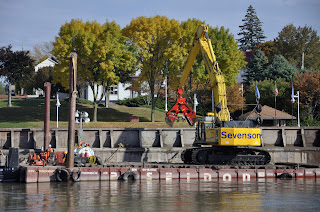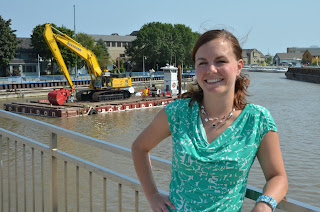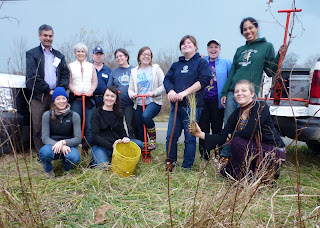The Sheboygan River, which was dubbed an “Area of Concern” in the 1980s for its high levels of environmental pollution and degradation, has just completed the final stages of a dredging project to clean and restore the river.
 Approximately 300,000 cubic yards of sediment (equivalent to 15,000 dump trucks full) contaminated with PCBs and PAHs were removed from the river between August 2012 and early January 2013. As a result, river-goers will enjoy a deeper river with better navigation and access, and a cleaner habitat for fish and wildlife to thrive.
Approximately 300,000 cubic yards of sediment (equivalent to 15,000 dump trucks full) contaminated with PCBs and PAHs were removed from the river between August 2012 and early January 2013. As a result, river-goers will enjoy a deeper river with better navigation and access, and a cleaner habitat for fish and wildlife to thrive.
IISG’s Caitie McCoy worked with a local team throughout 2012 to provide information to stakeholders and the public on the project. She completed a study in March (PDF) with University of Illinois student Ada Morgan to learn how to communicate the sediment remediation project and its benefits to the public. The study helped the team tailor outreach products and messaging for everyone who uses and visits the river.
 Work on the Sheboygan river will continue through 2013 to improve fish and wildlife habitats, both nearshore and underwater. “The dredging and habitat work are the last remaining actions necessary to take Sheboygan off a list of most polluted places in the Great Lakes,” wrote Caitie. “This has been an enormous team effort by the U.S. EPA and their partners, and we can’t thank the community enough for their support during the cleanup.”
Work on the Sheboygan river will continue through 2013 to improve fish and wildlife habitats, both nearshore and underwater. “The dredging and habitat work are the last remaining actions necessary to take Sheboygan off a list of most polluted places in the Great Lakes,” wrote Caitie. “This has been an enormous team effort by the U.S. EPA and their partners, and we can’t thank the community enough for their support during the cleanup.”
Educators from Illinois, Indiana, and Wisconsin attended IISG’s workshop Nov. 9-10 to increase the presence of Great Lakes science in their classrooms and to improve student awareness of issues related to the Lakes.
Illinois-Indiana Sea Grant partnered with Chicago’s Shedd Aquarium and the National Park Service Great Lakes Research and Education Center and the Dunes Learning Center to host the workshops, which provided opportunities for teachers to engage in science and math data collection and hands-on field work. Educators previewed Sea Grant’s Greatest of the Great Lakes and Fresh and Salt curricula to familiarize themselves with the diverse range of learning formats to enhance their science, math, and engineering units, as well as activities from Great Lakes in My World by the Alliance for the Great Lakes. Also, as part of the new Center for Great Lakes Literacy, workshop attendees learned how to help protect and restore coastal areas in the Lake Michigan watershed through a variety of teaching methods.
All of the teachers who attended this year’s workshop were excited to learn about programs like the Alliance for the Great Lakes’ Adopt-a-Beach, as well as the many exciting student stewardship activities offered by the Shedd Aquarium, the Dunes Learning Center, and the Indiana Dunes National Lakeshore botanists. They also enjoyed the hands-on activities, including using the Enviroscape model to learn about point source/non-point source pollution, and learning how to use GLNPO’s Hydrolab water quality monitoring instrument.
The feedback and comments from teachers was especially positive. Said one attendee, “You’ve given me great ideas about water quality, drinking water, invasive and noninvasive species, habitat restoration, and stewardship projects I can provide for my kids to become ‘Great Lakes literate.’”
To learn more about IISG’s educational programs and resources, visit our education webpage, and follow us on Facebook and Twitter for more events, workshops, and information.
This Center for Great Lakes Literacy project was funded through a grant from the U.S. EPA Great Lakes National Program Office.
 Last week, representatives from over 260 member organizations, students, educators, were joined by Illinois-Indiana Sea Grant staff at the Chicago Wilderness Congress 2012. The overall theme of the congress was “Shaping the Future of Regional Conservation,” and numerous presentations and panels offered information on green infrastructure, climate action, research, restoration, and more. 600 attendees from northeastern Illinois, northwest Indiana, and southeast Wisconsin helped make the event exciting and educational, bringing in examples of their conservation and environmental work.
Last week, representatives from over 260 member organizations, students, educators, were joined by Illinois-Indiana Sea Grant staff at the Chicago Wilderness Congress 2012. The overall theme of the congress was “Shaping the Future of Regional Conservation,” and numerous presentations and panels offered information on green infrastructure, climate action, research, restoration, and more. 600 attendees from northeastern Illinois, northwest Indiana, and southeast Wisconsin helped make the event exciting and educational, bringing in examples of their conservation and environmental work.
IISG’s Caitie McCoy and EPA research fellow Nishaat Yunus presented “Making the Invisible Visible: Engaging Children in Sediment Remediation of the Grand Calumet River,” which fit into the coalition’s education initiative and focus. The presentation described an educational program at two schools in Northwest Indiana designed to connect local youth to the Grand Calumet River Area of Concern while building scientific literacy. One challenge was to make a seemingly “invisible” problem like contaminated sediment “visible” and relevant to children living near the river. The students participated in the educational program from early February to June 2012, and attended a U.S. Environmental Protection Agency press event about the Great Lakes Legacy Act in June. Through presentations, engaging activities, and field trips, more than 120 students in 4th and 9th grades became familiar with Great Lakes Legacy Act remediation and restoration work and important ecological concepts. The 4th grade students learned about habitats, sediment, pollution, and invasive species, and the 9th grade class learned how to perform data collection, analysis, and reporting with the water samples they collected on a field trip to the river.
At the congress, Illinois-Indiana Sea Grant was also able to exhibit several education and outreach projects focused on community stewardship, including aquatic invasive species, proper pharmaceutical disposal, and habitat restoration, as well as program initiatives and accomplishments.
 IISG’s Kristin TePas summed up the event by saying, “The Chicago Wilderness Congress was a great opportunity to connect with conservation practitioners in the Chicago region and to learn about the various projects occurring locally.”
IISG’s Kristin TePas summed up the event by saying, “The Chicago Wilderness Congress was a great opportunity to connect with conservation practitioners in the Chicago region and to learn about the various projects occurring locally.”
You can read more about the conference, including detailed presentation descriptions, at the Chicago Wilderness website.
 Approximately 300,000 cubic yards of sediment (equivalent to 15,000 dump trucks full) contaminated with PCBs and PAHs were removed from the river between August 2012 and early January 2013. As a result, river-goers will enjoy a deeper river with better navigation and access, and a cleaner habitat for fish and wildlife to thrive.
Approximately 300,000 cubic yards of sediment (equivalent to 15,000 dump trucks full) contaminated with PCBs and PAHs were removed from the river between August 2012 and early January 2013. As a result, river-goers will enjoy a deeper river with better navigation and access, and a cleaner habitat for fish and wildlife to thrive. 



